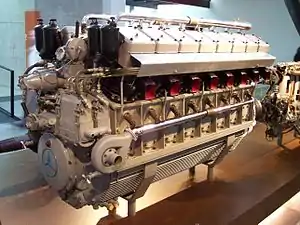| DB 602 | |
|---|---|
 | |
| Preserved Daimler-Benz DB 602 | |
| Type | Diesel V16 aero engine |
| National origin | Germany |
| Manufacturer | Daimler-Benz |
| First run | 1933 |
| Major applications | LZ 129 Hindenburg LZ 130 Graf Zeppelin II Schnellboot 1933 series S10...13 |
The Daimler-Benz DB 602, originally known as Daimler-Benz LOF.6, was a German diesel cycle aero engine designed and built in the early 1930s. It was a liquid-cooled upright V16, and powered the two Hindenburg-class airships. It has roughly the same displacement and weight of the Beardmore Tornado, which was used in the ill-fated R101, but has almost twice the power of the Tornado, showing Daimler-Benz's superior knowledge regarding diesel engine construction.
Also, these engines, under designation MB 502, powered four Schnellboots of 1933 series S10...13 (three engines on each). The engine was modified into V20 MB 501 of 2000 hp that had a variety of applications.
Applications
DB 602
MB 511
Engines on display
A preserved Daimler-Benz DB 602 is on display at the Zeppelin Museum Friedrichshafen.[1]
Specifications (DB 602)
Data from Flugzeug-Typenbuch. Handbuch der deutschen Luftfahrt- und Zubehör-Industrie 1944[2]
General characteristics
- Type: 16-cylinder liquid-cooled 50° V16 aircraft diesel engine
- Bore: 175 mm (6.89 in)
- Stroke: 230 mm (9.06 in)
- Displacement: 88.5 L (5,400.6 cu in)
- Length: 1,722 mm (67.8 in)
- Width: 739 mm (29.1 in)
- Height: 1,027 mm (40.4 in)
- Dry weight: 1,976 kg (4,356 lb) dry, unequipped
Components
- Valvetrain: Two intake and two exhaust valves per cylinder actuated via a single overhead camshaft per bank
- Fuel system: direct fuel injection
- Fuel type: Diesel
- Oil system: pressure feed with scavenge
- Cooling system: Liquid-cooled
Performance
- Power output:
- 1,115 PS (1,100 hp; 820 kW) at 1,650 rpm (maximum) at sea level
- 1,000 PS (986 hp; 735 kW) at 1,450 rpm (5 minutes) at sea level
- 850 PS (838 hp; 625 kW) at 1,350 rpm (max continuous) at sea level
- Specific power: 11.3 PS/L (0.18 hp/cu in; 8.31 kW/L)
- Compression ratio: 16:1
- Specific fuel consumption: 0.175 kg/PSh (0.391 lb/(hp⋅h); 0.238 kg/kWh) at max continuous
- Oil consumption: 0.008 kg/PSh (0.018 lb/(hp⋅h); 0.011 kg/kWh) at max continuous
- Power-to-weight ratio: 0.485 PS/kg (0.217 hp/lb; 0.357 kW/kg)
- B.M.E.P.: 6.4 atm (6.5 bar; 94 psi)
- Reduction gear planetary, 0.5:1
See also
Related lists
References
Notes
- ↑ Zeppelin Museum Friedrichshafen Archived 2009-08-07 at the Wayback Machine www.zeppelin-museum.de (German language) Retrieved: 17 September 2009
- ↑ Schneider, Helmut (Dipl.Ing.) (1944). Flugzeug-Typenbuch. Handbuch der deutschen Luftfahrt- und Zubehör-Industrie 1944 (in German) (Facsimile reprint 1986 ed.). Leipzig: Herm. Beyer Verlag. p. 389. ISBN 381120484X.
Bibliography
- Bingham, Victor (1998). Major Piston Aero Engines of World War II. Shrewsbury, UK: Airlife Publishing. ISBN 1-84037-012-2.
- Christopher, John (2013). The Race for Hitler's X-Planes: Britain's 1945 Mission to Capture Secret Luftwaffe Technology. Stroud, UK: History Press. ISBN 978-0-7524-6457-2.
- Gunston, Bill (2006). World Encyclopedia of Aero Engines: From the Pioneers to the Present Day (5th ed.). Stroud, UK: Sutton. ISBN 0-7509-4479-X.
- Neil Gregor Daimler-Benz in the Third Reich. Yale University Press, 1998